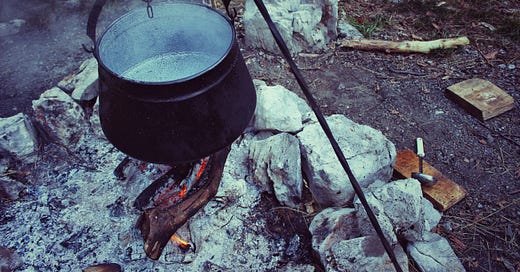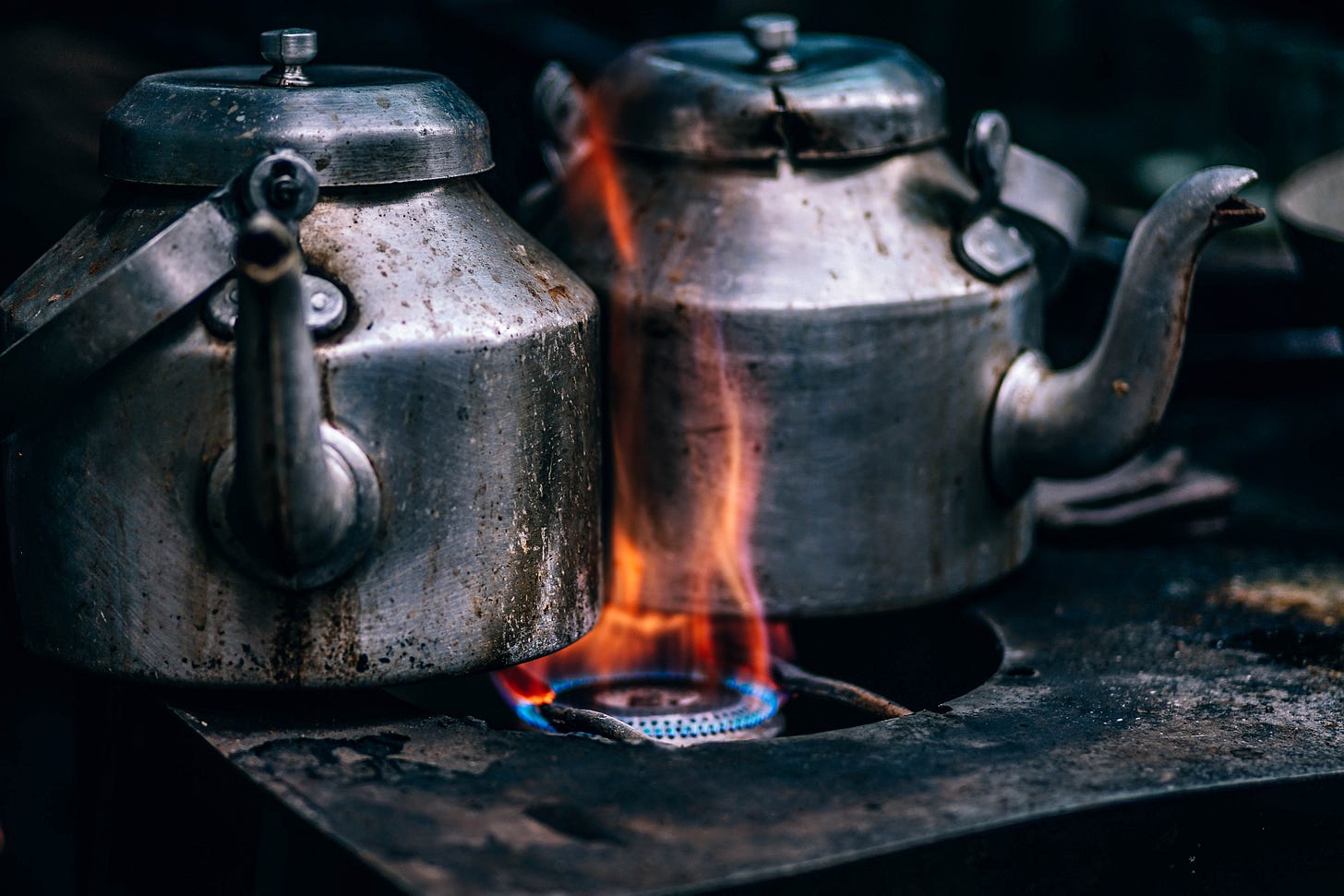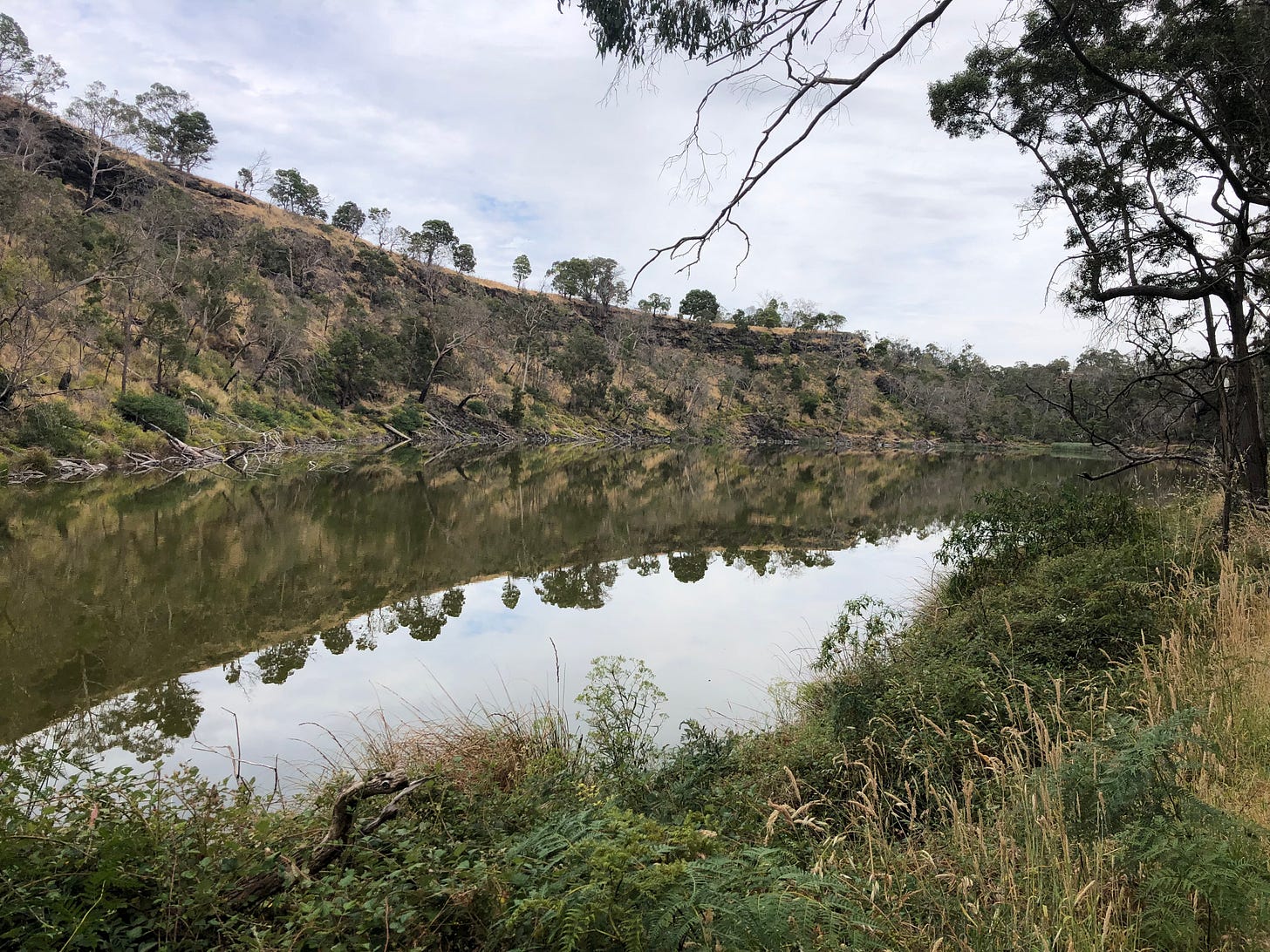This week I was in a second hand shop in Ballarat and saw some old cast iron kettles that had been varnished, rendering them unsuitable for use. I wondered at the practicality of varnishing a kettle and felt oddly disappointed that such beautiful specimens that might once have formed the centre of the family home were now rendered obsolete. I wanted to buy one and bring it home, but without the possibility of using it, it did not make sense. So I left them sadly, to another buyer, someone with enough sentimentality to position them as ornaments around the house.
I recall some years ago being taken by the idiom ‘the pot called the kettle black’, which is used to scold people for criticising the actions of another who is like them. It comes from a time when cooking was done over an open fire and pots and kettles both were black. But when I looked into it I was surprised to discover an alternative interpretation stemming from a time when kettles were made from copper, not cast iron, and polished to a high shine. The pot, seeing itself reflected, mistakenly called the kettle black.
I’m intrigued about this being a kitchen idiom, as kitchens are places of alchemy and transformation. How else can we explain the complicated processes by which raw ingredients are fashioned into a meal?
The way we understand idioms is culturally informed and in this case we tend to assume that the pot and the kettle are two separate and distinct entities, which interact by bouncing off each other like Indian rubber balls. Their interactions are limited by the hard edges of each. But in my experience people rarely have hard edges and our interactions are much more nuanced than this. When I engage with others parts of us merge or intermingle so I join with the them in some ways and they, in turn, join with me.
Some years ago now I read a book called ‘Secrets of Aboriginal Healing: A Physicist’s Journey with a Remote Australian Tribe’, by a man called Gary Holz who was diagnosed with MS and became a quadriplegic. A series of synchronicities led him to a remote aboriginal community where he received a reprogramming from two elders in that place. One of the things he talks about in that book is their ability to communicate telepathically. My understanding of this is that it arises out of a practice of interdependence, which in turn points back to the interrelatedness of humans and all other living things - including rocks, rivers, landforms, minerals and space. We are influenced and conditioned by all of these things, and we influence and condition them in return.
He writes, quoting a man he calls ‘Ron’, ‘The ultimate position we all want to occupy is to be interdependent. As youngsters we learn to be independent. As we go through life we tell ourselves that we should continue this behaviour... the truth is we need to be able to accept nurturing, support and caring from others as well.’ Its important to be able to maintain a degree of certainty and groundedness among other people, but its also necessary to be able to intermingle in the space in between. Again, Ron says: ‘We’re surrounded by intelligence, within our body as well as in the outside world. And that intelligence makes up the raw materials from which creation and change can take place.’ If that is how the world is, then both the pot and the kettle are in relationship, not just with each other but with the spaces in between.
Its funny about synchronicities because just this week someone on facebook posted an image of a fox woman that they had seen in a dream and when I looked at it, the thought crossed my mind that it could be me. I wondered what it would be like to shape-shift into a fox, and found my imagination wheeling out into the darkness, into the bushes around my chicken coop. No wonder I love chickens so much, I thought. And then I remembered, at half past midnight, that I had left the gate to the coop open and in a panic leapt out of bed and rushed outside, fully expecting that all my chickens would be gone. They weren’t, and I was grateful, and ceased to think about foxes and instead curled up under the covers and went to sleep.
What intrigues me about this is that sometimes someone else throws something out, a dream they had, a comment about something, an attitude or a suggestion of a thing, and it snags us. We see ourselves for a moment suspended in a word, thought or dream and it can take us by surprise. In that moment when we have been captured, maybe its just for a second or a fraction of a moment, an opening is created in which we can transform. But the opening is frequently so fleeting and requires a sharpness or agility of mind, body and spirit to recognise that most often what we do instead is react.
A good friend Kerry Wise told me a story this week about mutual acquaintances out at Trentham. Kerry lived next door to the Dunn family who were farmers and somewhat eccentric. She spoke about walking into their house and being met with a central fireplace over which they cooked. We’re not talking ancient history here, but early 1980s. Its strange isn’t it? We tend to think we are all on the same page as a society and a culture. We talk about advancement and progress and the accelerating rate of change, and its only when we look closer that we see that there are pockets of indifference, alternative ways of being in and seeing the world, and each of these is a window into a new way of being for us.
So maybe we need a different way of understanding this idiom. If we track back to its Spanish origins - it first appears in English in a translation of Miguel de Cervatnes’ Don Quixote, that has Sancho Panza criticising his master by saying ‘You are like what is said that the frying-pan said to the kettle, ‘Avant, black-brows’’ - we find there are many variations, one of which has the frying pan say to the kettle, ‘You have a black arse!’ I like this version much better because it describes with accuracy and humour the way the bottoms of pots and kettles get blackened before the rest. And it brings the pot and kettle together in a kind of intimate ribaldry that says, ‘I can call you that and get away with it because I have a black arse too!’
But I like to think that there’s more to it than that even. And that the pot and the kettle are in the process of transforming each other through their proximity and through their shared relationship with fire. And that when the pot says to the kettle ‘You have a black arse’ what she’s really saying is ‘There is part of me in you’, or even ‘Together in this fire we are being transformed’.
Over New Years I took the kids camping out at Budj Bim. We like the occasional homemade pizza and I wanted to try cooking one on the camp stove. It worked a treat. I’ve adapted the process for cooking over a campfire. You need a heavy based frypan, a rimmed fireplace, and either a sheet of tin or a large metal plate to put on top to trap the heat.
campfire pizza
to make the dough
take a quantity of good strong flour - i like to use spelt - about 200 gms will do, plus some extra for dusting. add yeast, 2tsp, a sprinkle of salt, warm water and a dash of olive oil. knead until you have a smooth dough and then for another five minutes to activate the yeast.
set aside in a warm place to rest.
if you are camping, go for a long walk, or if its hot, find somewhere to swim. when you come back to it in a few hours the dough should be risen, airy and light. sprinkle a little flour on top and punch it down into the container. if you can at this point, you can turn it out on a floured surface and knead until all the air is squeezed out. i just flattened it as best i could in the plastic tub that it rose in and set it aside.
prepare your fire and your toppings. you want a fireplace that is edged in earth, rock, brick, or some other heat-banking substance that will keep the fire from spreading and create a makeshift oven of sorts. put enough wood on the fire to make some good coals, as flame will burn your pizza almost immediately.
once you have a good bank of coals made, put together your pizza in the frying pan. slather in some olive oil. take a handful or two of dough and massage it across the base right out to the edges. spread on your tomato paste or passata or if you have neither then some slices of fresh tomato will do.
next you need cheese. i like a dusting of mozzarella on the base. cover this with toppings of your choice - some roadkill kangaroo and saltbush berries would go good in the mix. pop another layer of cheese on the top, or dot with feta or other gourmet cheeses of your choice. now its time to cook.
make yourself a bed of coals. above it and to each side, make a base with two robust branches, or some small stones. sit the frypan on top of the base and cover the entire fireplace with a sheet of tin or a metal hot plate. this is not a pizza oven, so you can’t leave the pizza without checking on it regularly and moving it around to make sure the cheese is melting and the base doesn’t burn. if the base cooks too quickly lift it higher off the coals, and if the cheese isn’t melting but the base is cooked, cover the pan with a heat-proof lid and hold it higher up. ours took about 15 minutes to cook.
this might seem a lot of effort for some pizza, but its well worth it to see the expression on the kids faces when you serve them up pizza in the bush.






